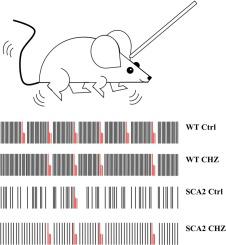Cell Calcium ( IF 4.3 ) Pub Date : 2020-11-16 , DOI: 10.1016/j.ceca.2020.102319 Polina A Egorova 1 , Aleksandra V Gavrilova 1 , Ilya B Bezprozvanny 2

|
Cerebellar Purkinje cells (PCs) fire spontaneously in a tonic mode, although the precision of this pacemaking activity is disturbed in many abnormal conditions involving cerebellar atrophy, such as many spinocerebellar ataxias (SCAs). In our previous studies we used the single-unit extracellular recording method to analyze spontaneous PC firing in vivo in the anesthetized SCA2-58Q transgenic mice. We realized that PCs from aging SCA2-58Q mice fire much less regularly compared to PCs from their wild type (WT) littermates and this abnormal activity can be reversed with an intraperitoneal (i. p.) injection of SK channel-positive modulator chlorzoxazone (CHZ). Here we used the same single-unit extracellular recording method to analyze the spontaneous firing in vivo in awake SCA2-58Q transgenic mice. For this purpose, we used the Mobile HomeCage (Neurotar, Finland) floating platform to immobilize the experimental animal's head during the recording sessions. We discovered that generally PCs from awake animals fired much more frequently and much less regularly than previously observed PCs from anesthetized animals. In vivo recordings from awake SCA2/WT mice revealed that complex spikes, which are generated by PCs in reply to the excitation coming by climbing fibers, as well as simple spikes, were much less frequent in SCA2 mice compared to their WT littermates. To test the effect of the SK channel positive modulation on the PCs firing activity in awake SCA2 mice and also the effect on their motor coordination, we started the CHZ trial in these mice. We discovered that the long-term i. p. injections of CHZ did not affect the spike generation in SCA2-58Q mice, however, they did recover the precision of this spontaneous pacemaking activity. Furthermore, we also showed that treatment with CHZ alleviated the age-dependent motor impairment in SCA2-58Q mice. We propose that the lack of precision in PC spike generation might be a key cause for the progression of ataxic symptoms in different SCAs and that the activation of calcium-activated potassium channels, including SK channels, can be used as a potential way to treat SCAs on the physiological level of the disease.











































 京公网安备 11010802027423号
京公网安备 11010802027423号